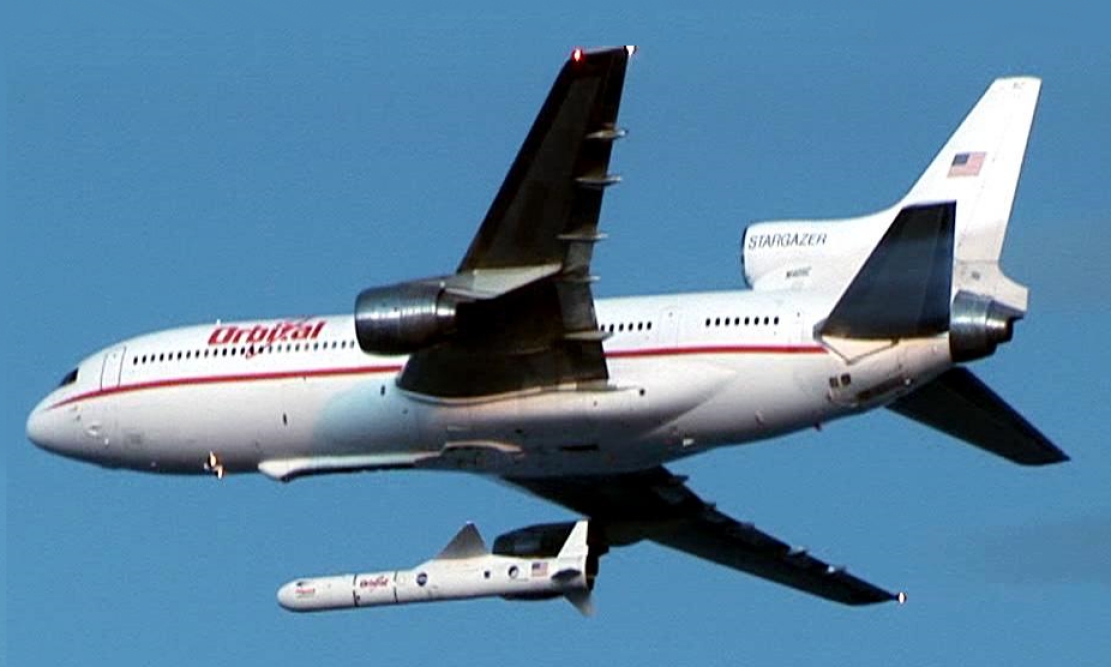
Pegasus
In-activeOrbital Sciences Corporation (OSC)
April 5, 1990
Description
The Pegasus is an air-launched rocket developed by Orbital Sciences Corporation (now part of Northrop Grumman Innovation Systems). Capable of carrying small payloads of up to 443 kilograms (977 lb) into low Earth orbit, the vehicle consists of three solid propellant stages and an optional monopropellant fourth stage. Pegasus is released from its carrier aircraft at approximately 40,000 ft (12,000 m), and its first stage has a wing and a tail to provide lift and attitude control while in the atmosphere.
Specifications
-
Stages
3 -
Length
16.9 m -
Diameter
1.27 m -
Fairing Diameter
― -
Launch Mass
18.0 T -
Thrust
580.0 kN -
Apogee (Sub-Orbital)
4000.0 km
Family
-
Name
Pegasus -
Family
― -
Variant
― -
Alias
― -
Full Name
Pegasus
Payload Capacity
-
Launch Cost
$40000000 -
Low Earth Orbit
443.0 kg -
Geostationary Transfer
Orbit
― -
Direct Geostationary
― -
Sun-Synchronous Capacity
―
Orbital Sciences Corporation
Commercial
None
OSCNone
Pegasus | APEX
Orbital Sciences Corporation | United States of AmericaAir launch to orbit
Aug. 3, 1994, 2:38 p.m.
Status: Launch Successful
Mission:
APEX (Advanced Photovoltaic & Electronic Experiment) successfully tested a wide array of advanced photovoltaic and electronic components in a harsh radiation environment, provided significant data to support improved designs for future space systems. During operation, APEX's highly elliptical orbit allowed the investigation of space plasma effects on high-voltage operation (current leakage at positive voltages and arcing at negative voltages) in the perigee region, plus the investigation of space radiation effects (decreased array power output from passage through the inner radiation belt) in the apogee region.
Elliptical OrbitPegasus | Array of Low Energy X-ray Imaging Sensors (ALEXIS)
Orbital Sciences Corporation | United States of AmericaAir launch to orbit
April 25, 1993, 1:56 p.m.
Pegasus | Satélite de Coleta de Dados-1 (SCD-1)
Orbital Sciences Corporation | United States of AmericaAir launch to orbit
Feb. 9, 1993, 2:30 p.m.
Long March 11
Unknown Payload
Oriental Spaceport mobile launch ship - Sea LaunchDetails TBD.
Falcon 9
Starlink Group 11-14
Space Launch Complex 4E - Vandenberg SFB, CA, USAA batch of 28 satellites for the Starlink mega-constellation - SpaceX's project for space-based Internet communication system.
Falcon 9
Starlink Group 6-81
Space Launch Complex 40 - Cape Canaveral SFS, FL, USAA batch of 29 satellites for the Starlink mega-constellation - SpaceX's project for space-based Internet communication system.
Electron
The Nation God Navigates (iQPS Launch 5)
Rocket Lab Launch Complex 1B - Rocket Lab Launch Complex 1, Mahia Peninsula, New ZealandSynthetic aperture radar Earth observation satellite for Japanese Earth imaging company iQPS.
Ariane 62
Sentinel-1D
Ariane Launch Area 4 - Guiana Space Centre, French GuianaSentinel-1D carries an advanced radar technology to provide an all-weather, day-and-night supply of imagery of Earth’s surface as part of the Sentine…

